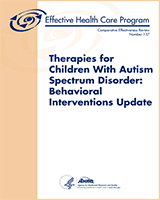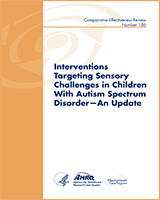NCBI Bookshelf. A service of the National Library of Medicine, National Institutes of Health.
Weitlauf AS, McPheeters ML, Peters B, et al. Therapies for Children With Autism Spectrum Disorder: Behavioral Interventions Update [Internet]. Rockville (MD): Agency for Healthcare Research and Quality (US); 2014 Aug. (Comparative Effectiveness Review, No. 137.)
This publication is provided for historical reference only and the information may be out of date.

Therapies for Children With Autism Spectrum Disorder: Behavioral Interventions Update [Internet].
Show detailsTable G-1Applicability of early intensive behavioral and developmental intervention studies
| Domain | Description of applicability of evidence |
|---|---|
| Population | Studies included both toddlers and preschool children (i.e., children from 2–5 years; range of mean ages: 20.94 – 55.7 months). Baseline cognitive, language, and adaptive scores typically fell within the impaired range, reflecting characteristics of young children with ASD in the community. Most participants were male. Where reported, other population demographic characteristics were mixed regarding race, ethnicity, language spoken, parental education level, and socioeconomic status. |
| Intervention | Interventions included early intensive behavioral intervention without (EIBI) and with (Parent training) large parent training components. Approaches ranged in terms of manualization, techniques (e.g., DIR vs. TEACCH), provider, setting (i.e., school vs. home; individual vs. group), frequency, and intensity. 14/25 studies provided at least 6 months of treatment and 11/25 provided at least a year. |
| Comparators | Comparators included eclectic interventions, “treatment as usual” in the community, lower levels of manualized treatments, providing manuals with no additional training/support, special education preschool curricula, DVD-based parent training, and parent support. As in the intervention groups, comparators varied by setting, provider, frequency, and intensity, all of which were inconsistently documented. |
| Outcomes | Studies commonly assessed IQ, language, autism severity, and adaptive behavior outcomes after anywhere from 2 weeks to 2 years of intervention. Many studies found that both groups improved in IQ, adaptive behavior, and language/communication skills. Others found differential treatment effects. Because most studies compared one treatment to another without controlling for frequency or intensity, it is not always clear whether improvement is due to receiving any treatment vs. specific treatment modalities. Some evidence emerged that baseline age, autism severity, language, and cognitive skills interacted with specific treatment types to predict differential outcomes. |
| Setting | Studies took place in home, clinic, and school settings in the United States, Canada, Israel, China, Sweden, Italy, Norway, the Netherlands, Australia, Thailand, and the United Kingdom. Participants were assigned to treatment groups in a variety of ways including random assignment, parental preference, educational system and governmental decisions, geographical location, and availability of services. |
Table G-2Applicability of social skills studies
| Domain | Description of applicability of evidence |
|---|---|
| Population | Studies typically included school-aged children (i.e. children from 4–13), typically male, diagnosed with high-functioning autism, with baseline cognitive scores typically within the average range, even though some studies also included children and classified them as high-functioning as long as they met an IQ score cutoff of 70 or above. The populations studied generally only reflect the IQ and language characteristics of school-aged children with ASD without concomitant cognitive and/or language deficits in the community. |
| Intervention | Social skills interventions varied widely in terms of scope and intensity. Examples included a few studies that replicated interventions using the manualized Skillstreaming model; a few studies that incorporated peer-mediated and/or group-based approaches; and interventions that focused on emotion identification and theory of mind training. One study examined long-term follow-up of the Children's Friendship Training program and another study was a Japanese pilot study of the Treatment and Education of Autistic and Related Communication Handicapped Children (TEACCH) model. The studies also varied in intensity, with the majority of the studies consisting of 1–2 hour sessions/week lasting for approximately 4–5 weeks; however, some of the group-based approaches lasted for 15–16 weeks. |
| Comparators | Comparators were varied but the majority of studies included a wait-list control group. Other comparative interventions included revised or updated versions of previously utilized interventions or variations of group makeup (i.e. peer group only versus peer group with a sibling; child-directed group interaction or peer-directed group interaction). |
| Outcomes | Studies varied widely in their assessment of outcome measures. Several studies measured learning of new skills specific to the treatment (i.e. Skillstreaming Knowledge Assessment). Several studies utilized parent-report of social skills, including scores on the Social Responsiveness Scale, the Social Skills Rating System, and the BASC-2. Other studies utilized behavioral ratings by staff and/or teachers on the child's social interactions and social network salience. Finally, some studies examined emotion identification or theory of mind measures. All of the studies were short-term in nature, with follow-up occurring approximately 2–3 months post-intervention, if follow-up was done at all. The results indicated that most studies reported short-term gains in social skills and emotion recognition as reported by parents or within study measures. However, maintenance and generalization of these skills beyond the treatment context had variable results. |
| Setting | Studies were conducted in the US, Australia, Japan, and Europe (The Netherlands) in primarily clinic settings, even though a few group-based interventions were utilized in the school/community setting, and the emotion-identification interventions utilizing media were implemented in the home setting. |
Table G-3Applicability of studies of interventions addressing conditions commonly associated with ASD
| Domain | Description of applicability of evidence |
|---|---|
| Population | Studies included children ages 4–16 with ADOS-confirmed ASD diagnosis and often with primary anxiety diagnosis. Most studies required IQ greater than 70 with children falling in the average range. Children were recruited from a range of sources including outpatient psychiatry clinics, schools, pediatrician's offices, parent and family support groups, university medical clinics and research centers. Children were mostly male, and primarily Caucasian in studies conducted within the US. |
| Intervention | Interventions consisted of cognitive behavioral therapy (CBT) typically provided on a weekly basis for 60–90 minutes over a period of four months although treat although treatment times ranged from 7 to 32 weeks. Interventions were typically manualized and included both children and parents. One study did not examine CBT rather examined parent training as an augmentation to risperidone. |
| Comparators | Most studies compared CBT to either wait list or treatment as usual controls, and two studies compared CBT to social skills therapies The study examining parent training augmentation compared participants on risperidone with parent training to those on risperidone without parent training. |
| Outcomes | Studies primarily targeted anxiety symptoms therefore the outcome measures included various measures of anxiety both at end of intervention and at a follow-up interval of 3 months to one year following termination of intervention. Measures of anxiety most commonly included the Anxiety Disorders Interview Schedule, the Spence Children's Anxiety Scale, the Multidimensional Anxiety Scale for Children and the Clinical Global Impressions-Severity Scale. Several studies additionally measured improvements in adaptive behavior measured by the Vineland Adaptive Behavior Scale as an outcome, and, one study measured improvements in executive functioning and one study measured improvements in emotion regulation as the primary outcome. The study assessing utilization of parent training augmentation of risperidone examined outcomes including irritability, maladaptive behaviors, socialization and communication. |
| Setting | Studies were primarily conducted in the US with one study conducted in Singapore. Interventions typically occurred in outpatient treatment centers and in the participants' homes. |
Table G-4Applicability of studies evaluating play/interaction-based interventions
| Domain | Description of applicability of evidence |
|---|---|
| Population | Studies included children between 21 and 75 months of age with confirmed ASD diagnoses. The majority of children were male and were generally recruited from populations of children already receiving intervention in early intervention settings, preschools, or specialty schools. Children in studies were representative of the larger population of children with ASD in early intervention programs. |
| Intervention | Interventions used approaches focusing on joint attention, with most joint attention interventions using elements of Kasari's 2006 model; play skills/pretend play with a typically developing peer model; imitation; and parental responsivity. On study modified the Hanen More than Words approach. Intervention was mediated by parents/caregivers, teachers, and interventionists. |
| Comparators | Comparators included early intervention without additional joint attention or interaction training or no specific intervention. |
| Outcomes | Targeted outcomes included joint attention and engagement, imitation, language, play skills, and social skills. |
| Setting | Studies were conducted in mainstream and ASD-specific preschools, specialty schools, mainstream public schools, and research centers in the US, Belgium, and Norway. |
Table G-5Applicability of studies evaluating other behavioral approaches
| Domain | Description of applicability of evidence |
|---|---|
| Population | Studies of neurofeedback included children between the ages of 8–12 years and had IQs in the average range (>70); children were recruited from a special education school and from the community. Studies of sleep interventions included children between 2 and 10 years of age. Participants were drawn from the Autism Treatment Network and from children attending a pediatrics and psychiatry clinic. Participants were generally reflective of the larger population of children with ASD and sleep issues. One study included young children (36–104 months) who may have issues with feeding/mealtime. |
| Intervention | Interventions included neurofeedback training, a sleep education pamphlet, and CBT with and without melatonin, parent education in sleep hygiene and in promoting appropriate mealtime behaviors. |
| Comparators | Comparators included no treatment/waiting list, group vs. individual training, and in one sleep study, melatonin alone, CBT+melatonin, or placebo. |
| Outcomes | Outcomes in neurofeedback studies included measures of executive function and social and communication skills. Sleep studies assessed sleep parameters including night wakings, time to fall asleep, sleep duration, and sleep anxiety. The feeding study assessed mealtime behaviors such as food acceptance. |
| Setting | Studies were set in the home and treatment centers in the US, the Netherlands, and Italy. |
- Applicability Tables - Therapies for Children With Autism Spectrum DisorderApplicability Tables - Therapies for Children With Autism Spectrum Disorder
- Characteristics and Outcomes of Studies of Early Intensive Behavioral and Develo...Characteristics and Outcomes of Studies of Early Intensive Behavioral and Developmental Interventions - Therapies for Children With Autism Spectrum Disorder
- Homo sapiens ALG3 alpha-1,3- mannosyltransferase (ALG3), transcript variant 1, m...Homo sapiens ALG3 alpha-1,3- mannosyltransferase (ALG3), transcript variant 1, mRNAgi|1653961913|ref|NM_005787.6|Nucleotide
- Caenorhabditis elegans BRCT domain-containing protein (W04A8.1), partial mRNACaenorhabditis elegans BRCT domain-containing protein (W04A8.1), partial mRNAgi|2735070888|ref|NM_001430674.1|Nucleotide
Your browsing activity is empty.
Activity recording is turned off.
See more...
